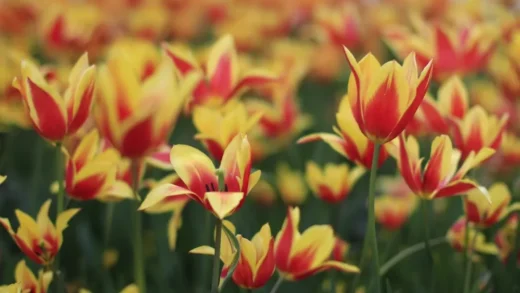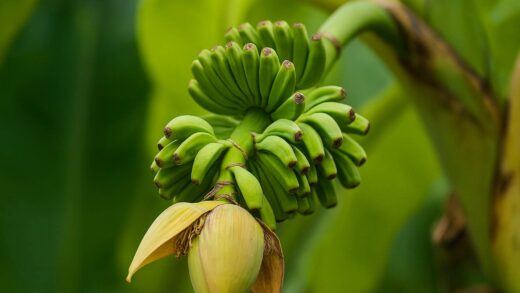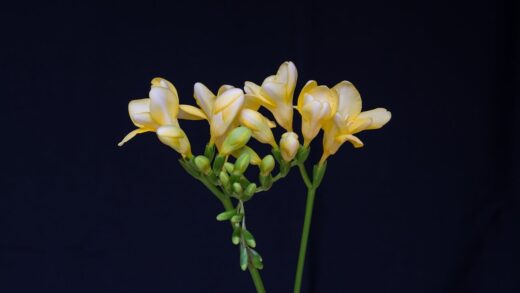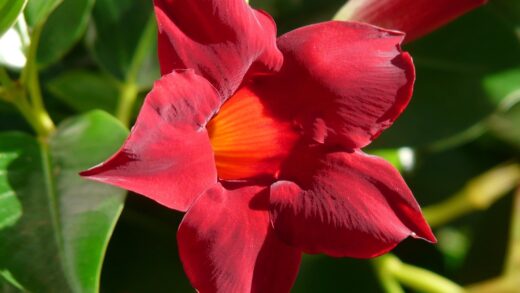American pokeweed is a robust and often misunderstood perennial that can be a striking addition to the landscape if managed correctly. Its large leaves, reddish stems, and dramatic clusters of dark purple berries create a bold, tropical effect in the garden that few other temperate plants can match. However, its vigorous growth habit and the toxicity of all its parts necessitate a knowledgeable and deliberate approach to its cultivation. Proper care is not just about helping the plant thrive, but also about ensuring it remains a safe and manageable feature within your garden’s ecosystem. Understanding its life cycle, its needs, and its potential for spreading is the first and most critical step for any gardener considering this unique plant.
The foundation of successful pokeweed care lies in appreciating its natural tendencies. This plant is a pioneer species, often one of the first to colonize disturbed or neglected land, which speaks to its resilience and adaptability. In a garden setting, this translates to a plant that is generally low-maintenance, tolerating a wide range of conditions that would challenge more delicate ornamentals. It develops a very deep and substantial taproot, which is the key to its drought tolerance and its ability to regenerate year after year. This taproot stores a significant amount of energy, allowing the plant to re-sprout with impressive vigor each spring, even if cut to the ground. Consequently, your care strategy should focus more on containment and management rather than intensive feeding or watering.
A crucial aspect of caring for American pokeweed involves a deep respect for its toxicity. Every part of the plant, including the leaves, stems, roots, and unripe berries, contains compounds that are toxic if ingested by humans, pets, and livestock. The roots are the most poisonous part of the plant. Therefore, it is essential to wear gloves when handling the plant, especially if you have sensitive skin or any cuts. When pruning or removing plants, be mindful of the sap, which can cause skin irritation. This toxic nature also means you must be strategic about its placement, keeping it far from vegetable gardens where its roots or berries could be accidentally harvested and away from areas frequented by children and pets who may be tempted by the attractive berries.
Long-term management is perhaps the most important component of care. American pokeweed can quickly become invasive if its spread is not controlled. The primary method of spread is through seeds, which are consumed by birds and then deposited elsewhere. To prevent unwanted seedlings from appearing all over your garden and neighboring properties, it is wise to remove the flower or berry stalks before the fruit fully ripens and becomes attractive to birds. Alternatively, you can allow the berries to develop for their ornamental value but must commit to diligently removing any volunteer seedlings that appear the following spring. Managing pokeweed is an ongoing commitment, not a one-time task.
Understanding its growth habit
American pokeweed exhibits a rapid and impressive growth cycle that defines its presence in the garden. Emerging from its perennial taproot in the spring, the plant sends up thick, fleshy shoots that can grow at an astonishing rate, often reaching their full height of two to three meters within a single growing season. These stems are initially green but develop a distinctive reddish or purplish hue as they mature, adding to the plant’s ornamental appeal. The growth is herbaceous, meaning the top growth dies back to the ground completely with the first hard frost, but the underground root system remains very much alive and ready for the next year. This annual cycle of vigorous growth and dieback is a key characteristic to consider in your garden design and maintenance plans.
More articles on this topic
The plant’s architecture is both simple and bold, characterized by a branching structure that supports large, simple, alternate leaves. These leaves can grow up to thirty centimeters long, contributing to the plant’s lush, almost tropical appearance. In late summer, the plant produces long, drooping clusters of small, white to greenish-pink flowers known as racemes. While the individual flowers are not particularly showy, the overall effect of these floral spikes is quite attractive. They are a valuable nectar source for various pollinators, adding ecological benefit to their ornamental qualities. Understanding this progression from vegetative growth to flowering is key to timing any pruning or management interventions.
Following the flowering period, the plant’s most dramatic feature develops: the berries. The small flowers give way to green berries that gradually ripen to a deep, inky purple-black. These berry clusters, or drupes, are heavy and cause the stalks to arch downwards, creating a beautiful and dramatic display that can last well into the autumn. It is this fruiting stage that requires the most attention from a management perspective. While visually stunning, these berries are a primary vector for the plant’s spread, as they are a favorite food source for many bird species who are immune to their toxins. The birds then disperse the seeds widely through their droppings.
The root system of American pokeweed is the engine of its powerful growth and persistence. It develops a large, deep taproot that can become incredibly thick and fleshy over time, resembling a large parsnip. This substantial underground structure is what makes the plant so difficult to eradicate once established and is also the most toxic part of the plant. This taproot enables it to survive harsh winters and prolonged droughts, storing the necessary resources to fuel the rapid growth of its shoots each spring. When you are caring for a pokeweed plant, you are essentially managing this powerful root system and the top growth it produces each year.
Soil and site selection
Choosing the right location for American pokeweed is fundamental to its successful and safe integration into your garden. This plant is highly adaptable and can grow in a wide variety of soil types, from sandy loams to heavier clays, but it truly thrives in rich, well-drained soil. It has a preference for soils with a high organic matter content, which mimics the woodland edges and disturbed grounds where it naturally prospers. When preparing a site, amending the soil with compost or well-rotted manure can help get the plant off to a strong start, though it is often unnecessary given the plant’s tenacity. The most critical soil factor is drainage, as the large taproot can be susceptible to rot in waterlogged or constantly saturated conditions.
More articles on this topic
In terms of soil pH, American pokeweed is not particularly demanding and will tolerate a fairly broad range, from slightly acidic to neutral (pH 6.0 to 7.0). It is a plant that readily adapts to existing conditions rather than requiring specific soil chemistry adjustments. Before planting, it is more important to consider the physical structure of the site. You should choose a location where its deep taproot will have ample room to grow without interfering with building foundations, pipes, or the root systems of other valuable plants. Because it can be very difficult to remove once established, the initial site selection should be considered a permanent decision.
The ideal location also takes into account the plant’s mature size and potential for spreading. Provide it with plenty of space, as a single mature plant can easily reach a height of three meters and a spread of one and a half meters in a single season. Planting it at the back of a border, along a fence line, or in a more naturalized or wilder part of the garden is often the best strategy. This allows it to create a dramatic backdrop without overwhelming smaller, more delicate plants. Consider its proximity to walkways and patios, not only due to its size but also to prevent the dark berries from dropping and staining surfaces.
Finally, the most responsible aspect of site selection involves public and family safety. Given the plant’s toxicity, it must be planted well away from any areas where children or pets play. It should also be located far from vegetable gardens to avoid any chance of accidental ingestion of its parts or cross-contamination. Siting it in a location where you can easily monitor it for unwanted seedlings is also a wise precaution. A well-chosen site is one that allows you to enjoy the plant’s beauty while easily managing its growth and mitigating any potential risks associated with its poisonous nature.
Managing its vigorous spread
One of the most active aspects of caring for American pokeweed is managing its natural inclination to spread. The plant reproduces primarily by seed, and a single mature specimen can produce thousands of seeds in a season. These seeds are encased in the fleshy, dark purple berries, which are highly attractive to birds like mockingbirds, robins, and cedar waxwings. The birds consume the fruit, and the seeds pass through their digestive tracts unharmed, ready to germinate wherever they are deposited. This efficient, bird-driven dispersal mechanism is why pokeweed seedlings can appear in the most unexpected corners of your garden and even in neighboring yards.
The most effective method for controlling this spread is to manage the berries. You have two main options for this. The first and most proactive approach is to remove the flower stalks shortly after they have finished blooming but before the berries begin to form. This completely prevents seed production for the year, though it does sacrifice the ornamental value of the dark berry clusters. The second option is to allow the berries to develop and ripen for their aesthetic appeal but to remove the entire berry stalks before the birds can strip them clean. This requires careful timing, as you want to enjoy the display for as long as possible without allowing for widespread seed dispersal.
In addition to managing the seed source, you must remain vigilant for any volunteer seedlings that may emerge. These are easiest to remove when they are young and their taproots have not yet had a chance to develop deeply. A young pokeweed seedling can be pulled by hand, especially after a rain when the soil is soft. If you miss this early window, you will likely need a sturdy garden fork or spade to dig out the developing taproot. It is crucial to remove as much of the root as possible, as even a small fragment left in the soil can potentially resprout into a new plant.
For established plants that are spreading vegetatively through their root systems, management becomes more physically demanding. While pokeweed primarily spreads by seed, a large, mature root crown can expand over time, sending up new shoots at its periphery. To contain this, you may need to engage in root pruning with a sharp spade, creating a barrier to its underground expansion. In situations where a plant has become too large or is growing in an undesirable location, complete removal is the only option. This involves a significant amount of digging to excavate the entire taproot, which can be a formidable task for a well-established plant.
Toxicity and safe handling
A responsible gardener must have a thorough understanding of the toxicity of American pokeweed. All parts of the plant—roots, stems, leaves, and berries—contain a complex mixture of chemical compounds, including saponins and phytolaccatoxin, which are poisonous to humans and most mammals if ingested. The concentration of these toxins varies throughout the plant, with the root being the most potent, followed by the leaves and stems, and finally the ripe berries. While birds can consume the berries without ill effect, they are toxic to people, and ingestion can cause severe gastrointestinal distress, including nausea, vomiting, and diarrhea. It is imperative that the plant is treated with respect and caution at all times.
Proper handling procedures are non-negotiable when working with pokeweed. Whenever you are pruning, cutting back, or attempting to remove the plant, it is essential to wear protective gloves and long sleeves. The plant’s sap can be absorbed through the skin and may cause a dermatitis-like rash or irritation in sensitive individuals. Avoid touching your face, especially your eyes and mouth, after handling any part of the plant until you have washed your hands thoroughly with soap and water. This simple precaution can prevent accidental poisoning and skin reactions, ensuring your interactions with the plant remain safe.
Disposal of plant material also requires careful consideration. Do not add pokeweed roots, stems, or leaves to your home compost bin, especially if you plan to use the compost on a vegetable garden. There is a risk that the toxic compounds may not fully break down during the composting process and could be taken up by edible plants. A safer method of disposal is to bag the plant debris and place it in your municipal green waste or trash, depending on local regulations. Never burn pokewed material, as the smoke can contain irritant compounds that could be harmful if inhaled.
Educating others about the plant is a key part of safe cultivation. If you have children, teach them from a young age that the pokeweed plant and its attractive berries are not for eating. It is also a good idea to inform neighbors, especially if they have children or pets, that you are growing a toxic plant in your garden. This transparency helps prevent accidental poisonings and fosters a responsible gardening community. By combining a clear understanding of its toxicity with consistent safe handling and disposal practices, you can enjoy the unique beauty of American pokeweed without compromising safety.
Long-term maintenance considerations
Caring for American pokeweed is not a short-term project; it requires a long-term maintenance strategy to keep it as a desirable garden feature rather than a problematic weed. The cornerstone of this strategy is the annual cutback. After the first hard frost in late autumn or early winter, the entire herbaceous top growth of the plant will die back to the ground. At this point, you should cut all the dead stems down to a few centimeters above the soil line. This tidies up the garden for the winter, removes material that could harbor pests, and most importantly, prevents the remaining berries from being dispersed over the winter months.
Another key long-term consideration is monitoring the plant’s root system and its immediate surroundings. Even with diligent seed head removal, an occasional seedling may go unnoticed. Make it a regular habit each spring to inspect the area around the parent plant for any new volunteers and remove them promptly. Additionally, be aware that the taproot of the main plant will continue to grow larger and more robust each year. This increased energy storage can lead to more vigorous top growth, so you may need to adjust your pruning or containment strategies over time to manage its increasing size and vigor.
Rejuvenation is not typically a concern for pokeweed as it is for many other perennials. The plant is incredibly self-sufficient and long-lived, and its annual dieback and regrowth from the taproot is its own form of renewal. You will not need to divide the plant to maintain its vigor; in fact, attempting to divide the massive taproot is an arduous and often unsuccessful task. The primary focus of long-term care remains on control and management, not on horticultural interventions to boost its health, as it is naturally a very healthy and resilient plant. Your main task is simply to provide it with a defined space and ensure it stays there.
Finally, consider the plant’s role in the evolving ecosystem of your garden over the years. While it provides food for birds and nectar for pollinators, its aggressive nature can also lead it to outcompete less vigorous neighboring plants for light, water, and nutrients. As your garden matures, you may need to reassess its location or the plants surrounding it. Be prepared to remove or thin out other plants that are being overshadowed by the pokewest’s large canopy, or alternatively, decide if the pokeweed itself needs to be removed to make way for a different garden design. A long-term perspective allows for this kind of adaptive management.
Seasonal care cycle
The care required for American pokeweed follows a distinct and predictable seasonal cycle, beginning in the spring. As the soil warms, new shoots will emerge with impressive speed from the ground where the plant grew the previous year. This is a critical time for management. You should decide how many shoots you want to allow to mature; a mature plant can have several thick stems, but you may prefer to thin them to just one or two for a less dense, more architectural look. This is also the prime time to be vigilant for and remove any unwanted seedlings that have germinated from the previous year’s seeds.
As the plant moves into the summer, your main focus will shift from emergence to maintenance and monitoring. The plant will grow rapidly during this period, developing its large leaves and achieving its full height. Generally, established plants require little to no supplemental watering unless you are experiencing a severe and prolonged drought. This is also the time when the plant will begin to produce its flower racemes. Your primary task during the summer is to decide on your seed management strategy: will you remove the flowers as they fade to prevent berry formation, or will you allow them to develop and plan to remove them later?
Autumn is the season when American pokeweed is at its most visually dramatic. The stems often deepen to a vibrant magenta, and the clusters of dark purple berries hang heavily from the branches, providing a striking contrast with the foliage as it begins to turn yellow. If you have chosen to allow the berries to ripen, your main task is to monitor them and the activity of local birds. The goal is to enjoy the display for as long as possible but to intervene and cut off the berry stalks before the birds have a chance to eat them all and disperse the seeds. This is a delicate balance of timing and observation.
With the arrival of winter, the care cycle for American pokewedown comes to a close. The first hard frost will signal the end of the growing season, causing the leaves to drop and the stems to die back. Once the top growth has withered, it is time for the final task of the year: cutting the entire plant back to the ground. This tidies the garden, prevents any remaining seeds from spreading, and prepares the plant for its dormant period. The massive taproot will safely rest underground, storing energy and waiting for the warmth of the following spring to begin the cycle anew.


















